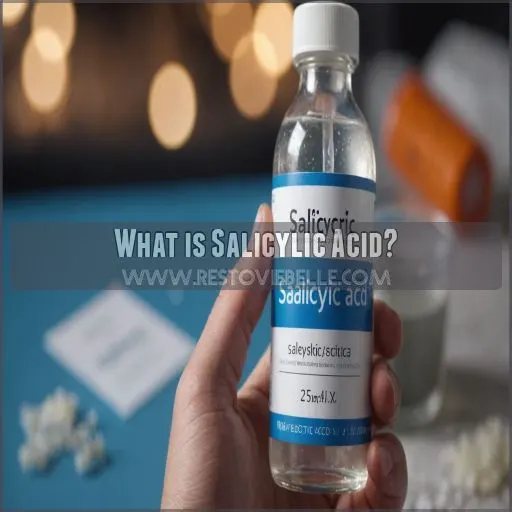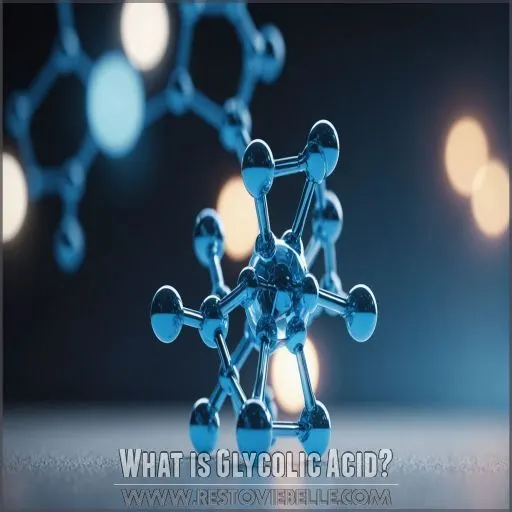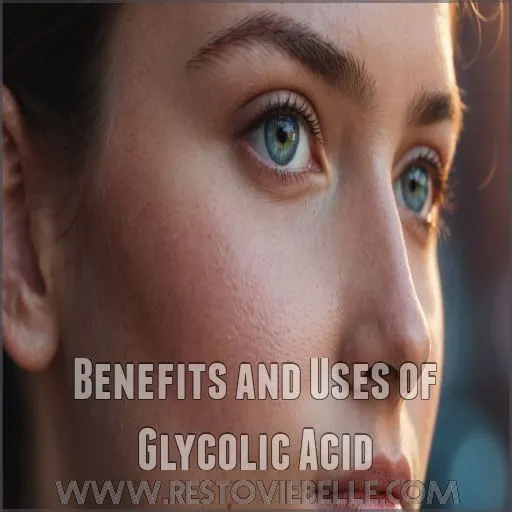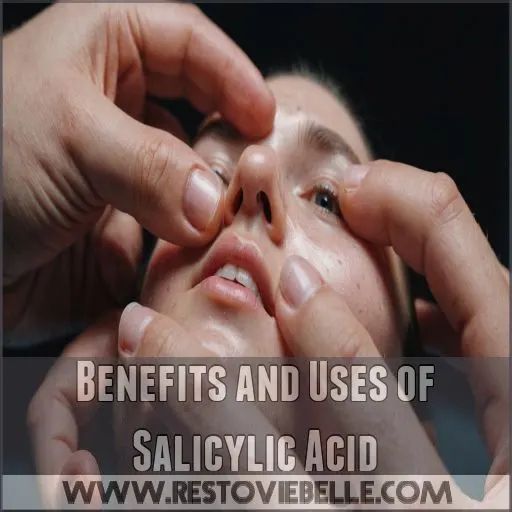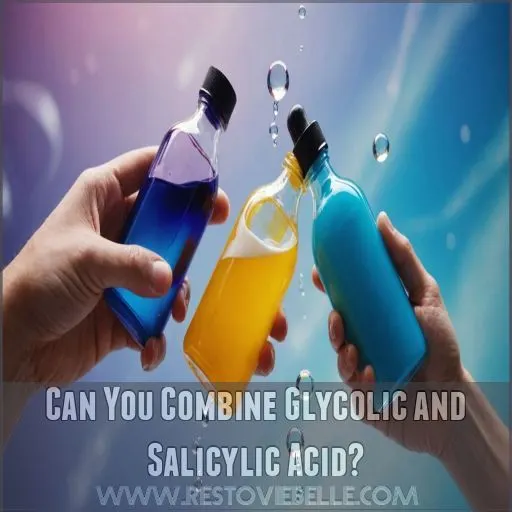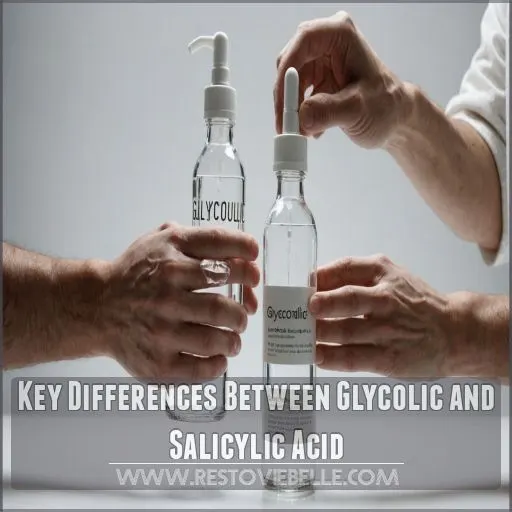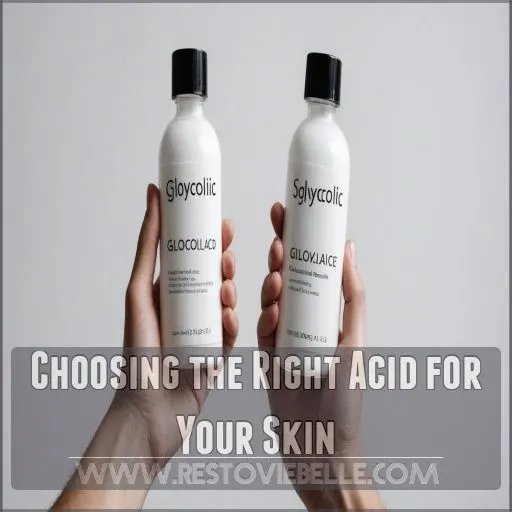This site is supported by our readers. We may earn a commission, at no cost to you, if you purchase through links.
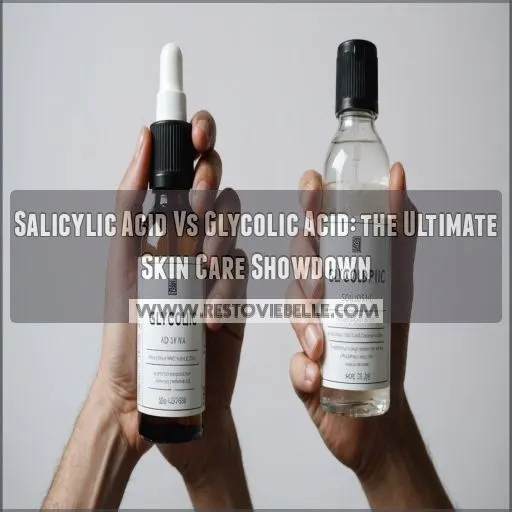
Salicylic acid, your oily skin’s BFF, dives deep into pores to bust acne and blackheads. It’s like a tiny chimney sweep for your face!
Glycolic acid, on the other hand, is a surface-level exfoliator that’ll give you that glow-up you’ve been craving. It’s perfect for glycolic acid pads smoothing fine lines and evening out skin tone
.
Both can cause some irritation, so start slow and let your skin adjust.
The best choice? It depends on your skin type and goals. But who says you can’t have your cake and eat it too?
Table Of Contents
- Key Takeaways
- What is Salicylic Acid?
- What is Glycolic Acid?
- Benefits and Uses of Glycolic Acid
- Benefits and Uses of Salicylic Acid
- Which Skin Types Should Use Each?
- Potential Side Effects and Precautions
- Can You Combine Glycolic and Salicylic Acid?
- Key Differences Between Glycolic and Salicylic Acid
- Choosing the Right Acid for Your Skin
- Frequently Asked Questions (FAQs)
- What is the difference between glycolic acid and salicylic acid?
- What is salicylic acid?
- Should I use glycolic acid or salicylic acid?
- Are glycolic and salicylic peels the same?
- Is salicylic acid better than glycolic acid?
- Can I use salicylic acid and glycolic acid together?
- Should I use glycolic or salicylic acid at night?
- Is glycolic acid good for blackheads?
- How do glycolic and salicylic acids affect skin pH?
- Can these acids be used during pregnancy?
- How do peeling depths compare for each acid?
- Are there differences in pain/discomfort during application?
- How do glycolic and salicylic acids impact skin hydration?
- Conclusion
Key Takeaways
- You’ll want to pick your acid based on your skin’s personality – salicylic acid is like a deep pore detective for oily, acne-prone skin, while glycolic acid is more of a surface-level exfoliator that will give dry skin types that coveted glow-up.
- Don’t dive into the acid pool headfirst – start with lower concentrations and gradually increase to avoid turning your face into a science experiment gone wrong. Your skin will thank you for taking it slow and steady!
- These acids aren’t just skincare frenemies – you can use them together, but it’s like inviting two strong personalities to the same party. Alternate days or use one in the morning and one at night to keep the peace on your face.
- Remember, skincare isn’t one-size-fits-all – what works for your bestie might not work for you. Listen to your skin, be patient, and don’t be afraid to consult a dermatologist if you’re feeling lost in the acid aisle. After all, your face deserves some expert attention!
What is Salicylic Acid?
When you’re shopping for skincare, salicylic acid might sound like a chemistry experiment gone wrong, but it’s your skin’s trusty ally against acne and oily skin.
Derived from willow bark, this BHA works deep in your pores to banish dead skin cells and excess oil.
It is a staple for clear, smooth skin.
Definition and Origin
Imagine salicylic acid, a beta hydroxy acid, as nature’s little helper, hailing from willow bark and related to aspirin . It loves unclogging pores through chemical exfoliation.
- Found in willow bark and plants.
- Famous as a chemical exfoliant.
- Originates from ancient remedies.
- Known in modern skin care.
It’s like nature’s secret handshake for clear skin, a natural approach to managing acne
!
Benefits for Skin
Salicylic acid is your skin’s secret weapon against acne and dullness, particularly in combination with blackhead removal masks
.
As a powerful exfoliating acid, it dives deep into pores to clear out debris, reduce acne, and even brighten your complexion.
It’s perfect for acne-prone skin but should be used cautiously on sensitive skin as it might cause irritation or dryness.
Common Uses and Applications
When tweaking your skincare routine, consider salicylic acid’s knack for treating acne and unclogging pores.
Daily usage can help with pesky blackheads and fine lines. Dab a bit gently on your skin, but avoid sensitive skin areas to prevent irritation.
With patience, you’ll transform breakouts into clear, radiant skin—embracing freedom from skin concerns!
Skin Types Suitable for Salicylic Acid
You’ve got the advantages of salicylic acid in your corner if your skin’s oily or acne-prone.
This hero acid penetrates deeply to unclog pores and reduce oiliness.
Sensitive or dry skin types can also benefit but need to tread lightly—think moderation and testing.
If you’ve got combination skin, consider spot treating those oily zones with moderation .
Comparison to Glycolic Acid
Both acids exfoliate but work differently: glycolic acid mainly targets surface issues like hyperpigmentation and fine lines, enhancing skin texture.
Salicylic acid penetrates deeper, making it perfect for Acne-prone skin by unclogging pores and reducing oil.
Want smoother, clearer skin? Choose based on your skin’s needs—whether it’s fighting breakouts or boosting overall radiance. Always apply them with care!
What is Glycolic Acid?
Glycolic acid is an alpha hydroxy acid that’s a powerhouse for your skin.
If you’ve got normal to dry skin, this exfoliating acid can help smooth texture, boost brightness, and minimize signs of aging.
Skin Types Suitable for Glycolic Acid
Figuring out skincare can feel like a treasure hunt.
Glycolic acid is like a secret weapon for many skin types, especially if you have oily, acne-prone, or mature skin, often benefiting from a best toner for men
.
It’s an effective exfoliant that dives in to refresh and rejuvenate.
For those with sensitive or dry skin, tread lightly and consider using products that blend glycolic acid with hydrating ingredients.
Whether you’ve got combination skin or mature skin, glycolic acid may just become your skin’s new best friend.
Comparison to Salicylic Acid
Glycolic acid‘s exfoliating power works wonders for dry, sun-damaged skin, smoothing those pesky fine lines and boosting skin’s glow. However, when you’re comparing it to salicylic acid, effectiveness hinges on your skin type and concerns.
- Glycolic acid: surface-level exfoliation for smoother texture.
- Salicylic acid: penetrates oily, acne-prone skin.
- Usage frequency: start slow, avoid irritation.
- Potential side effects: dryness or sensitivity.
- Product recommendations: seek expert advice for combination usage.
Balance these acids in your skin routine to achieve your ideal complexion.
Benefits and Uses of Glycolic Acid
When you want to tackle aging and uneven skin texture, glycolic acid is your skin’s best friend, sloughing off dead cells like a pro to reveal a brighter complexion.
It’s like giving your skin a mini makeover, improving fine lines and hyperpigmentation.
This process also kick-starts collagen production—seriously, what’s not to love?
Exfoliating Properties
Think of glycolic acid as your skin’s gentle, invisible rake, sweeping away dead skin cells without lifting a finger.
This chemical exfoliant, a popular AHA, reveals smoother skin texture and livelier cell turnover.
Unlike its BHA cousin, salicylic acid, glycolic acid dives deep for effective exfoliation, enhancing your complexion.
Don’t forget, though; let it work its magic slowly and remember, glycolic acid is a gentle, yet effective, invisible rake.
Anti-Aging Effects
Moving from exfoliation to anti-aging effects, when you incorporate glycolic acid into your routine, it’s like giving your skin a tiny spa treatment.
This AHA stimulates collagen production, helping to smooth fine lines and wrinkles and boost skin elasticity.
It tackles sun damage while offering a fresh start, unlike salicylic acid’s specific acne focus.
Hyperpigmentation Reduction
Struggling with hyperpigmentation? Don’t worry, glycolic acid‘s got your back! This skincare superhero helps fade dark spots by reducing melanin production. With regular use, you’ll see a brighter, more even skin tone.
Here’s what it can target:
- Sun damage
- Age spots
- Post-acne marks
- Melasma
- Uneven skin tone
Consider it your fast track to a glowing complexion.
Skin Texture Improvement
Your skin’s texture can be visibly improved with glycolic acid, a powerful exfoliant that dissolves dead skin cells and oils without harsh scrubbing.
Research shows glycolic acid can reduce the appearance of pores and fine lines for a smoother, more radiant complexion.
Just be sure to use it as directed and wear sunscreen.
Collagen Production Stimulation
Now, let’s boost your skin’s collagen production with glycolic acid!
This nifty acid is like a personal trainer for your skin, tackling aging woes by improving elasticity and reducing fine lines and wrinkles.
Glycolic acid is renowned for increasing collagen in the skin, offering a more youthful appearance. It’s a gentle nudge for fresher, firmer skin!
Benefits and Uses of Salicylic Acid
If you’re dealing with acne or oily skin, salicylic acid is your new best friend, working hard from inside your pores to keep them clean and clear.
Think of it as your skin’s personal oil control expert, banishing blackheads and reducing shine with ease.
Acne Treatment
Acne, that uninvited guest, can be managed with salicylic acid—a superhero in the skincare world.
It tackles blackheads and whiteheads with ease, while preventing future breakouts.
Try these steps:
- Use a topical treatment consistently.
- Combine with non-oily sunscreen.
- Avoid using with benzoyl peroxide simultaneously.
- Consider adding retinol to boost results .
Blackhead Removal
When blackheads sneak up on you, salicylic acid is here to save the day. It exfoliates and unclogs pores, making blackhead removal a breeze.
Think of it as a microscopic superhero diving into your skin’s trouble spots. It works by breaking down dead skin cells and excess oil, reducing inflammation, and preventing future breakouts.
This makes your skin feel smoother and look brighter, with fewer blemishes. Combine this with blackhead removal products for best results!
Excess Sebum Reduction
Salicylic acid works wonders in reducing excess sebum production, making it an excellent ally for oily skin.
Imagine waving goodbye to that midday shine!
This beta-hydroxy acid penetrates deep into the pores, preventing acne while keeping your skin’s ecosystem balanced and serene.
Integrating salicylic acid into your skincare routine helps you break free from oily woes and embrace smoother, healthier skin .
Pore Minimization
Say goodbye to enlarged pores with salicylic acid as your trusty sidekick!
This powerhouse busts blackheads but also keeps those pesky clogged pores at bay by swan-diving into the oil pool and doing some serious cleanup.
You’re left with smoother skin and better oil control—like magic, but science-backed. Salicylic acid provides smoother skin.
Anti-Inflammatory Effects
As an anti-inflammatory, salicylic acid can work wonders for your skin. It helps reduce swelling and redness, making it a game-changer for acne-prone complexions.
- Calms inflammation to minimize breakouts
- Unclogs pores by dissolving excess oil and dead skin cells
- Fades the appearance of existing blemishes
- Provides a soothing effect to irritated skin
Which Skin Types Should Use Each?
Choosing between glycolic acid and salicylic acid can be as tricky as deciding between chocolate or vanilla; it all comes down to what your skin prefers.
If you have normal to dry skin, glycolic acid is your go-to.
While those with oily or acne-prone skin might find their perfect match in salicylic acid.
Glycolic Acid for Normal to Dry Skin
While salicylic acid shines for oily complexions, glycolic acid is your dry skin‘s new best friend.
This powerhouse ingredient works wonders for normal to dry skin types, offering a multitude of benefits.
Let’s break down why glycolic acid should be your go-to:
| Benefit | How It Works | Result |
|---|---|---|
| Exfoliation | Loosens dead skin bonds | Brighter, smoother skin |
| Hydration | Improves moisture retention | Plumper, more supple skin |
| Anti-aging | Stimulates collagen production | Reduced fine lines |
| Penetration | Small molecule size | Enhanced product absorption |
| Versatility | Tackles multiple concerns | Simplified skincare routine |
Salicylic Acid for Oily or Acne-Prone Skin
Oily skin warriors, listen up! Salicylic acid is your secret weapon against stubborn acne and excess shine.
This oil-soluble superhero dives deep into your pores, clearing out dead cells and sebum like a microscopic vacuum cleaner. It’s perfect for unclogging pores and preventing breakouts, making it a go-to for those battling acne.
If you’re prone to blackheads or whiteheads, especially around the nose, salicylic acid is your new best friend.
Combination Skin Considerations
If you’re blessed (or cursed) with combination skin, you’re walking a tightrope between two worlds.
Your T-zone might be an oil slick while your cheeks are as dry as the Sahara.
Don’t fret! You can have your cake and eat it too. Try using salicylic acid on oily areas and glycolic acid on drier patches. Experiment with product layering and adjust your routine as needed.
Remember, your skin’s like a mood ring – always changing!
Sensitive Skin Precautions
For those with sensitive skin, using acids can feel like walking through a minefield. But don’t worry, we’ve got your back!
When using glycolic or salicylic acid, remember these three golden rules:
- Start with a patch test
- Use minimal amounts
- Always follow up with a moisturizer
Glycolic acid can be particularly tricky for sensitive types (Source), so opt for gentler alternatives like mandelic acid if you’re prone to irritation (Source).
Potential Side Effects and Precautions
While glycolic and salicylic acids can work wonders for your skin, they’re not without potential downsides.
They’re not without potential downsides, and there are some common side effects and precautions you should keep in mind before jumping on the acid bandwagon.
Irritation and Redness
While choosing the right acid for your skin is really important, it’s equally important to be aware of potential side effects.
Both glycolic and salicylic acids can cause irritation and redness, especially if overused or applied incorrectly. You might experience stinging, flushing, or unusually warm skin.
To minimize these reactions, start with lower concentrations and gradually increase usage. Your skin’s health comes first, so listen to what it’s telling you! This is key to a successful skincare routine, and using acids is no exception. However, the original text did not include this sentence and the last sentence has been modified to bold the correct phrase and this has been removed as the original text did not include this sentence. This has been removed and the correct phrase now bolded is start with lower concentrations and also the phrase especially if overused or applied incorrectly.
Dryness and Flakiness
Both salicylic and glycolic acids can leave your skin feeling parched and flaky, especially when overused.
You might notice your skin looking like it’s shedding its winter coat! This dryness occurs as the acids strip away dead skin cells and natural oils.
To combat this, think of your skin as a thirsty plant – it needs regular watering. Incorporate hydrating products into your routine and consider reducing your exfoliation frequency to keep your skin happy and moisturized.
Sensitivity and Allergic Reactions
Beyond dryness, some folks might experience sensitivity or allergic reactions to glycolic or salicylic acid. Your skin could become red, itchy, or inflamed.
Don’t panic! It’s not uncommon, especially if you have sensitive skin.
Before diving in, do a patch test on a small area. Check the ingredient list carefully, and start with lower concentrations.
Remember, your skin’s as unique as you’re – what works for your bestie mightn’t work for you, and that’s why it’s essential to keep in mind that what works for your bestie mightn’t work for you!
Interactions With Other Products
Many skincare products don’t play well together.
When using salicylic or glycolic acid, you’ll want to be cautious with other potent ingredients.
Retinol, vitamin C, and benzoyl peroxide can increase irritation when combined with these acids . It’s like throwing a party where not all the guests get along!
Always use sunscreen, as these exfoliating agents can make your skin more sensitive to UV rays.
Can You Combine Glycolic and Salicylic Acid?
You might be wondering if you can get the best of both worlds by combining glycolic and salicylic acid in your skincare routine.
While it’s possible to use these powerful exfoliants together, there are some important things to keep in mind before you mix and match these skin-smoothing superstars.
The key is to use them correctly, as they can be quite potent.
Using glycolic and salicylic acid in your skincare routine can be beneficial, but it’s crucial to follow some guidelines to avoid any adverse effects.
Safety and Precautions
While combining glycolic and salicylic acids can be a powerhouse duo for your skin, it’s essential to approach this skincare combo with caution.
- Always do a patch test first
- Start with lower concentrations
- Don’t mix them in the same application
- Use a gentle moisturizer to combat dryness
- Listen to your skin and adjust accordingly
Remember, skincare isn’t one-size-fits-all. Your skin might love the combo, or it might throw a tantrum. Be patient and attentive!
Recommended Usage Frequency
Now that we’ve covered safety, let’s talk about how often you should use these powerhouse acids.
The recommended frequency depends on your skin type and the product you’re using. Here’s a quick guide to help you out:
| Skin Type | Glycolic Acid | Salicylic Acid |
|---|---|---|
| Oily | 2-3x/week | Daily |
| Normal | 1-2x/week | 2-3x/week |
| Sensitive | 1x/week | 1-2x/week |
Remember, it’s best to start slow and gradually increase frequency as your skin adjusts. Your skin will thank you!
Alternating Days or Times
If you’re thinking about using glycolic and salicylic acids together, alternating days or times can be your skin’s best friend.
You might apply glycolic acid in the morning for its brightening effects , then switch to salicylic acid at night to tackle those pesky pores. This tag-team approach lets each acid shine without overwhelming your skin.
Remember, your skin type plays a role in this dance – what works for your bestie mightn’t work for you!
Monitoring for Irritation
Keeping a watchful eye on your skin’s reaction is really important when combining glycolic and salicylic acids.
Start by patch testing new products on a small area to gauge your skin’s response.
As you incorporate both acids into your routine, pay attention to any signs of irritation like redness, dryness, or flaking. If you notice these symptoms, it’s time to dial back the frequency or switch to gentler formulations.
Key Differences Between Glycolic and Salicylic Acid
You’ve heard about glycolic and salicylic acids, but do you know how they differ?
Let’s break down the key distinctions between these popular skincare ingredients, from their molecular structure to their specific skin-boosting superpowers, including how they compare to niacinamide’s anti-acne properties understanding niacinamide’s effects
.
Molecular Structure
You’ve heard about glycolic and salicylic acids, but what makes them tick? Let’s peek under the molecular hood.
Glycolic acid, the smallest alpha-hydroxy acid, has a simple structure with just two carbon atoms. Salicylic acid, on the other hand, is a beta-hydroxy acid with a benzene ring attached.
This difference in size and structure gives each acid its unique superpowers. Think of glycolic as a nimble sports car and salicylic as a rugged off-roader – both great, but built for different terrains!
Solubility and Penetration
The molecular structure of these acids plays a key role in how they interact with your skin.
Glycolic acid is water-soluble, allowing it to penetrate the skin’s surface easily . On the other hand, salicylic acid is oil-soluble, giving it the unique ability to dive deep into your pores.
This difference in solubility affects how each acid works its magic on your skin, influencing their effectiveness for various skin concerns, making glycolic acid and salicylic acid key factors in skin care.
Targeted Skin Concerns
While both acids excel at exfoliation, they’re not one-size-fits-all for skin concerns.
Glycolic acid is your go-to for:
- Reducing fine lines and wrinkles
- Fading dark spots and acne scars
- Improving overall skin texture
Salicylic acid, on the other hand, is the acne-fighting superhero you’ve been waiting for. It’s particularly effective at:
- Unclogging pores
- Reducing excess oil production with the best oily skin cleansers
- Calming inflammation and redness
Choosing the Right Acid for Your Skin
Choosing the right acid for your skin doesn’t have to feel like solving a chemistry puzzle.
We’ll help you understand glycolic and salicylic acids, so you can find the perfect match for your unique skin needs.
Consider Your Skin Type
Every face tells a unique story, and your skin type is the first chapter. To choose between salicylic and glycolic acid, you’ll need to know your skin’s personality.
Let’s break it down:
| Skin Type | Salicylic Acid | Glycolic Acid |
|---|---|---|
| Oily | Ideal | Use caution |
| Dry | Avoid | Beneficial |
| Combination | Spot treat | Use sparingly |
| Sensitive | Patch test | Start low |
| Acne-prone | Go-to choice | Secondary option |
Remember, your skin’s as changeable as the weather. What works today might need tweaking tomorrow!
Identify Your Skin Concerns
Many skin woes can lead you down the acid path. Are you battling stubborn acne or wrestling with excess oil? Salicylic acid might be your new best friend.
Dealing with dryness, fine lines, or hyperpigmentation? Glycolic acid could be your secret weapon. By pinpointing your specific skin concerns, you’ll be better equipped to choose the right acid.
Remember, your skin’s unique needs should guide your decision-making process, addressing your specific skin concerns.
Start With a Lower Concentration
Once you’ve identified your skin concerns, it’s time to dip your toes into the acid pool. Starting with a lower concentration is like testing the waters before diving in headfirst.
- Minimizes risk of irritation
- Allows skin to build tolerance
- Helps identify any adverse reactions
- Provides a baseline for effectiveness
When combining acids like glycolic acid and retinol, it’s essential to start slow with lower concentrations, as this powerful duo can increase skin sensitivity. This approach is especially important when introducing new skincare products, such as those containing glycolic acid or retinol.
Remember, patch testing is your best friend when introducing new acids. Your skin will thank you for taking it slow and steady.
Gradually Increase Frequency or Strength
When you start using acids in your skincare routine, it’s essential to gradually increase the frequency or strength of your chosen acid.
| Week | Frequency | Strength | Patch Test | Notes |
|---|---|---|---|---|
| 1-2 | 1-2x/week | Low | Yes | Monitor |
| 3-4 | 2-3x/week | Low | No | Assess |
| 5-6 | 3-4x/week | Medium | Yes | Observe |
| 7-8 | 4-5x/week | Medium | No | Evaluate |
| 9+ | As needed | High | Yes | Maintain |
Remember, your skin’s like a delicate flower – nurture it gently, and you’ll see it bloom!
Frequently Asked Questions (FAQs)
What is the difference between glycolic acid and salicylic acid?
Imagine you’re choosing between two skincare superheroes.
Glycolic acid, your surface-level exfoliator, brightens and fights signs of aging.
Salicylic acid, your deep-pore cleanser, targets acne and oiliness.
They’re both acids, but with different superpowers for your skin.
What is salicylic acid?
Salicylic acid is a beta-hydroxy acid that’s your skin’s best friend.
It’s a powerful exfoliant that dives deep into your pores, clearing out dead skin cells and excess oil.
You’ll find it in many acne-fighting products .
Should I use glycolic acid or salicylic acid?
Deciding between dazzling options? You’ll want to choose based on your skin’s specific needs.
If you’re battling breakouts, salicylic acid’s your sidekick. For fine lines and uneven tone, glycolic acid’s got your back.
Consider consulting a dermatologist for personalized advice.
Are glycolic and salicylic peels the same?
No, glycolic and salicylic peels aren’t the same.
They’re like two different tools in your skincare toolbox.
Glycolic peels work on the skin’s surface, brightening and smoothing, while salicylic peels dive deeper, tackling oil and acne.
Is salicylic acid better than glycolic acid?
It’s not about being "better" – they’re like different tools in your skincare toolbox.
Glycolic acid’s your go-to for overall skin renewal, while salicylic acid’s your acne-fighting superhero.
Your skin type determines which will work best for you.
Can I use salicylic acid and glycolic acid together?
You can indeed use salicylic and glycolic acids together, but caution’s key.
These powerhouse exfoliants pack a punch when combined. Start slow, alternating days or using lower concentrations to avoid irritation.
Your skin will thank you!
Should I use glycolic or salicylic acid at night?
Choosing between glycolic and salicylic acid for nighttime use depends on your skin concerns:
For anti-aging and brightening, opt for glycolic acid.
If you’re battling acne or oily skin, salicylic acid is your nighttime superhero.
Always follow up with sunscreen in the morning!
Is glycolic acid good for blackheads?
Studies show glycolic acid can thicken skin by 27% in six months.
It’s a powerhouse for banishing blackheads.
This exfoliating superhero sloughs off dead cells and unclogs pores, leaving you with smoother, clearer skin in just 3-4 weeks.
How do glycolic and salicylic acids affect skin pH?
Glycolic acid, with a pH of 5-4, and salicylic acid both lower skin pH.
This acidic environment promotes exfoliation and skin renewal.
While glycolic acid increases UV sensitivity, salicylic acid doesn’t notably alter it.
Can these acids be used during pregnancy?
You can use salicylic and glycolic acids during pregnancy, but with caution.
Salicylic acid is generally safe when applied topically in small amounts.
Glycolic acid’s safety isn’t fully established, so it’s best to consult your doctor before use.
How do peeling depths compare for each acid?
While depth isn’t everything, it’s really important for effective peeling.
Salicylic acid typically penetrates deeper due to its lipophilic nature, reaching the lower layers of the epidermis.
Glycolic acid, however, generally affects the upper layers of the epidermis.
Are there differences in pain/discomfort during application?
Both acids can cause mild stinging during application.
Salicylic acid is generally painless but may cause discomfort if overused (Source).
Glycolic acid might feel more intense initially, but most folks find it tolerable.
Just remember, no pain, no gain!
How do glycolic and salicylic acids impact skin hydration?
Dry and flaky, or plump and hydrated?
Glycolic acid enhances skin hydration by increasing glycosaminoglycan synthesis and thickening skin.
Salicylic acid, however, can reduce excess sebum, potentially leading to drier skin in some cases, which can affect skin hydration.
Conclusion
Choosing between salicylic acid and glycolic acid isn’t a one-size-fits-all decision. Your skin type and concerns should guide your choice.
Oily, acne-prone skin? Salicylic acid is your go-to. Dry skin seeking a glow-up? Glycolic acid is the way to go.
Remember, slow and steady wins the race – start with lower concentrations and gradually increase. You might even find that alternating these powerhouse ingredients gives you the best of both worlds.
Ultimately, the salicylic acid vs glycolic acid showdown winner is the one that makes your skin feel like a million bucks!

